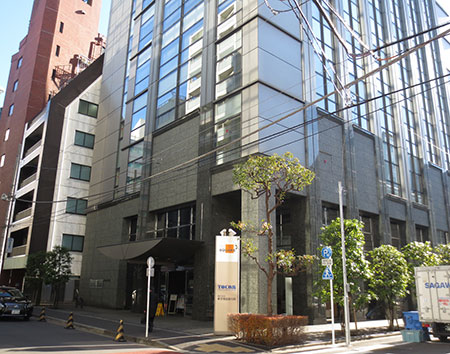
40th Anniversary-The Story of TOCOM (vol.1)~Established Through the Integration of 3 exchanges in Tokyo
Nov. 22, 2024
Once, there were 3 commodity futures exchanges in Tokyo, they merged and Tokyo Commodity Exchange for Industry (Tokyo Commodity Exchange at present-TOCOM) was established on November 1, 1984. It’s been 40 years this year.
As expected by those involved, in the 2000s, the exchange-TOCOM-was booming with annual trading volume ranking second after New York Mercantile Exchange (NYMEX) at one time. However, the exchange is a subsidiary of Japan Exchange Group (JPX) now, and the precious metal futures market and the rubber futures market that were once traded on TOCOM, a single exchange, have been transferred to Osaka Exchange, the other subsidiary of JPX, so TOCOM is an exchange specializing in energy products now. After the merger, TOCOM’s functions were moved to the building of Tokyo Stock Exchange, the other subsidiary of JPX, and the site of TOCOM was sold to a major hotel chain in Japan, so the building of TOCOM was demolished and a hotel is currently being built there.
One exchange of the predecessor exchanges of TOCOM was Tokyo Gold Exchange, which was established in February 1982 with the listing of gold. The establishment of Tokyo Gold Exchange was the first commodity futures exchange in 26 years since Nagoya Grain Exchange that was established in 1956. On the other hand, since 1970s, the challenge was to integrate the commodity futures exchanges by region and to unify overlapping commodity futures markets. However, regarding integration, there were many practical problems such as treatment of member shares and setting up an office that needed to be resolved, therefore, it didn’t make much progress.
However, two integrations have been achieved in 1984. In October, Osaka Chemical-fiber Exchange and Osaka Three Products Exchange merged to form Osaka Textile Exchange, and in November, Tokyo Textile Exchange, Tokyo Rubber Exchange and Tokyo Gold Exchange merged to form Tokyo Commodity Exchange for Industry.
In February, 1983 before the integration, the first meeting was held for the integration of the three exchanges-Tokyo Textile Exchange, Tokyo Rubber Exchange and Tokyo Gold Exchange. And at the meeting in May, 1984, the three exchanges have agreed to aim for integration on November 1 in the same year.
At that time, the three exchanges were conducting floor trading using hand gestures. Therefore, at the chief meeting of market division by the three exchanges, to unify the markets, 19 persons in charge of leading the transactions at the trading floors were divided into four teams, and for market communalization measures, two of the four teams were in charge of one trading floor to treat fiber, precious metal and rubber markets from May, 1984.
At the same time, regarding institutional issues, preparation of articles of incorporation and various regulations, three subcommittees were set up to discuss. One of specific items to be considered by those subcommittees was investment amounts. At that time, the amount of Tokyo Textile Exchange was 300,000 yen, Tokyo Rubber Exchange was 500,000 yen and Tokyo Gold Exchange was 1,000,000 yen. Therefore, the problems that seemed to be difficult to navigate were how the amounts would be unified and what the ownership ratio should be, etc.
As for the numbers of members at those exchanges in 1984, Tokyo Textile Exchange was 95 (Among them, the number of commodity futures traders was 35), Tokyo Rubber Exchange was 58 (29) and Tokyo Gold Exchange was 159 (45). Therefore, at the time of integration, the number of members would be 312 (Among them, the number of commodity futures traders would be 109 ), but there was overlap, so actually, the number of members would be 212 (Among them, the number of commodity futures traders would be 62). It would become a big household, so careful adjustment required.
As for the ownership ratio, the key was how to handle the building and land of Tokyo Textile Exchange (Tokyo Commodity Exchange for industry after integration).
The agreement was reached in September, 1984. The following contents have been decided.
Ⅰ.The building of Tokyo Textile Exchange shall be reserved as the exclusive interest of the members and this right will be specified in the articles of incorporation.
Ⅱ. Rental income will be treated as exchange income after integration.
Ⅲ. Regarding the number of investment units, among 157 units on Tokyo Textile Exchange, 87 units on Tokyo Rubber Exchange and 440 units on Tokyo Gold Exchange, the number of investment units on Tokyo Rubber Exchange with a lot of surplus assets will increase by 3 times to 261. The initial investment amount per unit will be approximately 300,000 yen, and it will be 800,000 to 1,000,000 yen after 3-4 months in the process of property arrangement.
Ⅳ. Surplus shares on precious metal and rubber markets will be deposited in the form of special collateral, and reductions in investment amount should be avoided as much as possible.
Officer composition was to be made up of 10 persons each of trading companies, makers and commodity futures traders from the three commodity futures exchanges, 30 persons in total. As for standing committees, general affairs committee and dispute settlement committee were to be combined into one, and member screening committee, market management committee and product quality rating committee were to be placed in the textile, rubber and gold markets respectively.
Although the name of the new exchange was decided to be“Tokyo Commodity Exchange for Industry”, initially, the name of“Tokyo Commodity Exchange”was the first choice from the perspective of spreading the word internationally. However, the Ministry of Agriculture, Forestry and Fisheries (MAFF) filed a complaint and opposed to the new exchange using the name of “Tokyo Commodity Exchange” that seems as if it represents the exchanges in Tokyo despite the fact that there is Tokyo Grain Exchange, so the new exchange added “for Industry” as a last resort.
(to be continued)
reference:Japanese page
(Futures Tribune・issued November 19, 2024 ・no.3325)
Link(Japanese site)
©2022 Keizai Express Corp.